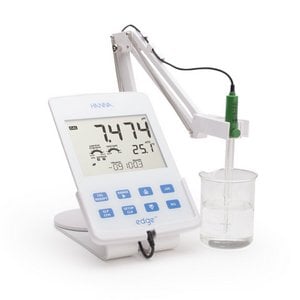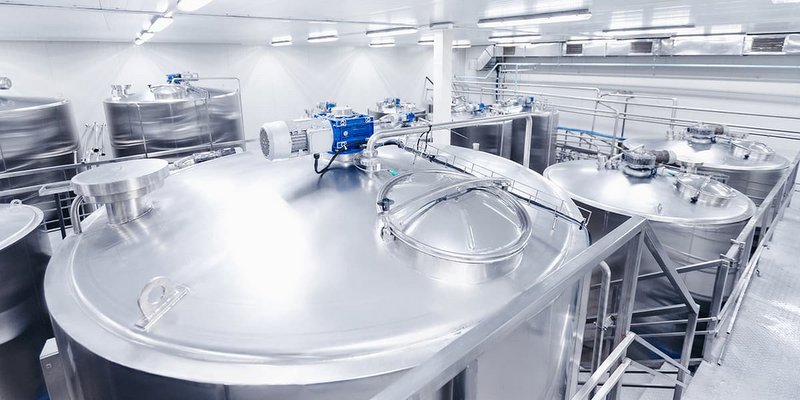Throughout the brewing process, enzymes are vital to a consistently good tasting beer. Like wine, beer is produced by yeast fermentation, based on reducing sugars or sugars that are able to be fermented. Unlike wine, beer does not naturally contain the sugars necessary for fermentation and instead relies on enzymes from the malted grains to break down starch to fermentable sugars. Enzymes, while playing different roles throughout the brewing process, are particularly important during the stages of mashing and fermentation. In relation to enzyme activity, pH and temperature are important factors to monitor during these stages.
 Both pH and temperature have a direct effect on the efficiency of enzyme activity. Exceedingly high or low pH values can result in sluggish or inactive enzyme activity. Temperatures that fall too low or high in regards to the optimum range will have varying effects on the activity of the enzymes being used. As with most chemical reactions, increased temperatures cause a faster reaction rate. This is also true for enzymatic reactions, but only to a certain degree. Up until a specified temperature, which is enzyme-specific, the reaction rate will increase; once the maximum temperature for that enzyme is reached, the reaction rate will sharply decelerate and the enzymes may start to denature. Conversely, enzymes can remain inactive if the temperature is too low.
Both pH and temperature have a direct effect on the efficiency of enzyme activity. Exceedingly high or low pH values can result in sluggish or inactive enzyme activity. Temperatures that fall too low or high in regards to the optimum range will have varying effects on the activity of the enzymes being used. As with most chemical reactions, increased temperatures cause a faster reaction rate. This is also true for enzymatic reactions, but only to a certain degree. Up until a specified temperature, which is enzyme-specific, the reaction rate will increase; once the maximum temperature for that enzyme is reached, the reaction rate will sharply decelerate and the enzymes may start to denature. Conversely, enzymes can remain inactive if the temperature is too low.
The first stage in which it is important to monitor enzyme activity is mashing. Mashing is the step in the brewing process in which the malted grain is steeped in hot water. The purpose of this step is to activate the enzymes that are responsible for converting the malted grain into fermentable sugars. Enzymes are selective catalysts, and once they bind to the grain substrate, the hydrolysis reaction that breaks down the starch into simple sugars is greatly accelerated. After the enzymatic process is complete, the water, grains and newly produced sugars are in suspension. Further separation of the solid and liquid components is necessary to produce wort, the extracted liquid which contains the fermentable sugars such as maltose, glucose, sucrose and fructose.
During mash, both pH and temperature play a vital role in the efficiency of starch breakdown. Note that brewers may utilize different enzymes to achieve certain characteristics in their final product. Each enzyme group operates at slightly different temperatures and pH ranges, but generally the breakdown of starch into fermentable sugars is optimal at a temperature between 60° to 69° C (140° to 156° F) and pH between pH 4.5 and 6.0. Brewers can adjust the temperature of their mash accordingly, and compounds such as phosphoric acid, lactic acid and brewing salts such as gypsum and calcium carbonate may be used to increase or decrease the pH as needed.
Further along in the brewing process is fermentation, where enzymes also play a vital role. There are several phases that occur during fermentation to achieve the primary goal of conversion; the sugars that were produced during mashing are taken up by the yeast as food, and alcohol is then produced as the desired byproduct, along with carbon dioxide. This conversion process occurs through the yeasts’ utilization of enzymes, which are secreted in order to break down the sugars present in the wort.
Yeasts are considerably affected by temperature, and if beer is not fermented within the appropriate temperature range for the type of strain used, adverse characteristics can develop in the final product. If the temperature remains too low during fermentation, the yeast will become dormant and the fermentation process will be incomplete; if the temperature is too high, the production of fusel alcohols is encouraged, producing medicinal, solvent-like off flavors.
As a living catalyst, yeast maintains a pH around 6.5 within its cells; however, the preference is to inhabit a more acidic environment. During fermentation, the pH should be lower to accommodate the yeast and also to ensure microbial stability and consistent flavoring of the beer; an optimal pH range during fermentation is between pH 4.1 and 4.3.
The mashing and fermentation stages are just two examples where enzymes play a role in the brewing process. The role of these enzymes in breaking down starches and sugars is dependent on both pH and temperature, as both parameters can have significant effects on the efficiency of the process and ultimately, the final product. By closely monitoring the pH and temperature, brewers can be confident that the enzymes are working efficiently to help achieve their desired brew.
This article was provided by Hanna Instruments. For more information, please visit the Hanna Instruments website.





Temperature, pH impact on enzymes http://t.co/v8mZznPDpk via @craftbrewingbiz
Temperature, pH impact on enzymes http://t.co/m29xsbBjmh via @craftbrewingbiz #craftbeer
Annie Mattil liked this on Facebook.
Ryan Salisbury liked this on Facebook.
Jason Marentette liked this on Facebook.
RT @CraftBrewingBiz: Temperature, pH impact on enzymes: http://t.co/1veFSf3dMe @hannausa
Hammer Szewczyk liked this on Facebook.
Gregory Evantash liked this on Facebook.
Henrique De Luca liked this on Facebook.
Jason Marentette
Jerry Elliott liked this on Facebook.
Jared Read liked this on Facebook.
RT @CraftBrewingBiz: Temperature, pH impact on enzymes: http://t.co/1veFSf3dMe @hannausa